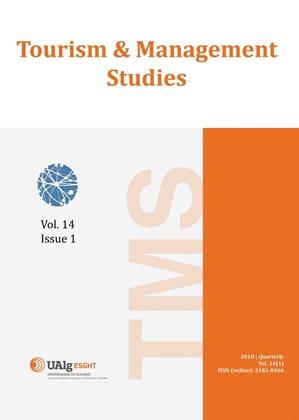Birdwatcher profile in the Ria Formosa Natural Park
Keywords:
Birdwatching, birdwatcher profile, Environmental awareness, Ria Formosa, AlgarveAbstract
In the Algarve the potential for birdwatching tourism is widely recognized, especially in the Ria Formosa Natural Park (RFNP). This study aims to describe birdwatchers’ profile in the RFNP. For this purpose a survey was applied. The results show that the most frequent nationalities of birdwatchers are: British (39%), Dutch (17%) and Portuguese (17%). The majority of birdwatchers are male (55%) and married (57%). The average age is 50 years old. They are highly educated (74% have an academic degree). Concerning profession, the most frequent answer was retired (41%). Respondents are committed to the activity as the majority possess special equipment and practice birdwatching in vacations. This study also tests if nationality is related to other characteristics of the birdwatchers, by using the Kruskal-Wallis and the Chi-square tests. Overall, the results of this study highlight that regional management organizations should invest in developing birdwatching in the RFNP.
References
Amaral, S. D. (2009). A avifauna como meio de valorização turística da Ria Formosa – Faro. (Unpublished Master’s Thesis). University of Algarve, Portugal.
Ballantyne, R., Packer, J., & Hughes, K. (2009). Tourists’ support for conservation messages and sustainable management practices in wildlife tourism experiences. Tourism Management, 30(5), 658–664. doi:10.1016/j.tourman.2008.11.003
Ceia, F. R., Patrício, J., Marques, J. C., & Dias, J. A. (2010). Coastal vulnerability in barrier islands: The high risk areas of the Ria Formosa (Portugal) system. Ocean & Coastal Management, 53(8), 478-486. doi:10.1016/j.ocecoaman.2010.06.004
Cole, J, S., & Scott, D. (1999). Segmenting participation in wildlife watching: a comparison of casual wildlife watchers and serious birders. Human Dimensions of Wildlife, 4(4), 44-61. doi:10.1080/10871209909359164
Connell, J. (2009). Birdwatching, twitching and tourism: towards an Australian perspective. Australian Geographer, 40(2), 203-217. doi:10.1080/00049180902964942
Czajkowski, M., Giergiczny, M., Kronenberg, J., & Tryjanowski, P. (2014). The economic recreational value of a white stork nesting colony: A case of ‘stork village’ in Poland. Tourism Management, 40, 352-360. doi:10.1016/j.tourman.2013.07.009
Eubanks Jr, T.L., Stoll, J.R. & Ditton, R.B. (2004). Understanding the diversity of eight birder sub-populations: socio-demographic characteristics, motivations, expenditures and net benefits. Journal of Ecotourism, 3(3), 151-172. doi:10.1080/14664200508668430
Green, R. J., & Jones, D. N. (2010). Practices, needs and attitudes of birdwatching tourists in Australia. Queensland: Cooperative Research Center for Sustainable Tourism.
Guimarães, M. H., Nunes, L. C., Madureira, L., Santos, J. L., Boski, T. & Dentinho, T. (2014). Measuring birdwatchers preferences: A case for using online networks and mixed-mode surveys. Tourism Management, 46, 102-113. doi:10.1016/j.tourman.2014.06.016
ICNF – Instituto de Conservação da Natureza e Florestas (2015). Parque Natural da Ria Formosa: Classificação | Caracterização. Retrieved from ICNF website: http://www.icnf.pt/portal/ap/p-nat/pnrf/class-carac
Jackson, S. (2007). Attitudes towards the environment and ecotourism of stakeholders in the UK tourism industry with particular reference to ornithological tour operators.
Journal of Ecotourism, 6(1), 34-66. doi:10.2167/joe126.0
Jafari, J. (2003). Encyclopedia of tourism. New York. Routledge.
Jones, D. N. & Buckley, R. (2001). Birdwatching Tourism in Australia. (Wildlife Tourism Research Report Series nº 10). Queensland: Cooperative Research Center for Sustainable Tourism.
Lee, C., Lee, Jin-Hyung, K., Tae-Kyun & Mjelde, J.W. (2010). Preferences and willingness to pay for birdwatching tour and interpretative services using a choice experiment. Journal of Sustainable Tourism, 18(5), 695-708. doi:10.1080/09669581003602333
Machado, A. (2011). Bird-watching Tourism in Europe: case study of the Algarve. (Unpublished Master’s Thesis). Bournemouth University, United Kingdom.
Ministério do Plano e da Administração do Território (1987). Decreto Lei 373/87, de 9 de Dezembro. Retrieved from Diário da República website: http://dre.tretas.org/dre/44878/.
Ministro, J. S. & Miguel, S. (2009). Birdwatching no Algarve – Propostas de Estruturação e Organização. Faro. Entidade Regional de Turismo do Algarve.
Mogollón, J.M.H., Cerro, A. M. C. & Durán, J.M.G. (2011). Propuestas para el desarrollo y comercialización del turismo ornitológico en Extremadura. Cuaderno de Turismo, 28, 93-119. Retrieved from: http://revistas.um.es/turismo/article/view/147241/131411
Moore, R. L., Scott, D., & Moore, A. (2008). Gender-Based Differences in Birdwachters’ Participation and Commitment. Human Dimensions of Wildlife, 13(2), 89-101. Doi:10.1080/10871200701882525
Newton, A. & Mudge, S.M. (2003). Temperature and salinity regimes in a shallow, mesotidal lagoon, the Ria Formosa, Portugal. Estuarine, Coastal and Shelf Science, 57(1-2), 73–85. doi:10.1016/S0272-7714(02)00332-3
Reynolds, P. C., & Braithwaite, D. (2001). Towards a conceptual framework for wildlife tourism. Tourism Management, 22(1), 31-42. doi:10.1016/S0261-5177(00)00018-2
Ribeiro, J., Monteiro, C.C., Monteiro, P., Bentes, L., Coelho, R., Gonçalves, J. M.S., Lino, P.G., & Erzini, K. (2008). Long-term changes in fish communities of the Ria Formosa coastal lagoon (southern Portugal) based on two studies made 20 years apart. Estuarine, Coastal and Shelf Science, 76(1), 57-68. doi:10.1016/j.ecss.2007.06.001
Roig, J. L. (2008). El turismo ornitológico en el marco del postfordismo, una aproximación Teórico-Conceptual. Cuadernos del Turismo, 21, 85-111. Retrieved from: http://revistas.um.es/turismo/article/view/25001
Scott, D. & Thigpen, J. (2003). Understanding the birder as tourist: segmenting visitors to the texas hummer/bird celebration. Human Dimensions of Wildlife: An International Journal, 8(3), 199-218. doi: 10.1080/10871200390215579
Sociedade Polis Litoral, SA (2010). Avaliação Ambiental do Plano Estratégico da Intervenção de Requalificação e Valorização da Ria Formosa: Relatório Ambiental Final. Volume 1. Lisboas: Nemus – Gestão e Requalificação Ambiental, Lda.
Tisdell, C. A. & Wilson, C. (2004). Economic, wildlife tourism and conservation: three case studies. Queensland: Cooperative Reserach Center for Sustainable Tourism.
Turismo de Portugal (2006). Turismo de Natureza. 10 Produtos estratégicos para o desenvolvimento do turismo em Portugal. Lisboa: Ministério da Economia e da Inovação.
Turismo do Algarve (2012). Birdwatching Guide to the Algarve. Faro: Gráfica Comercial. Faro.
Vowles, G. A. & Vowles, R. S. (1994). Breeding Birds of the Algarve. Vila Real de Santo António: Centro de Estudos Ornitológicos no Algarve.
Wright, J. (1995). Birders and twitchers: Towards developing typologies. Tourism and Leisure: Towards the Millennium. Eastbourne. Leisure Studies Association.
Downloads
Published
Issue
Section
License
Copyright (c) 2018 Tourism & Management Studies

This work is licensed under a Creative Commons Attribution-NoDerivatives 4.0 International License.
The journal retains published articles’ copyrights, but they are simultaneously licensed under the Creative Commons Attribution License (CC BY-NC-ND), which allows individuals’ to share the relevant papers as long as authorship and publication in this journal are duly acknowledged.



